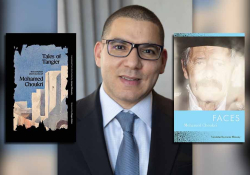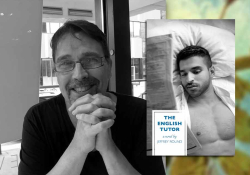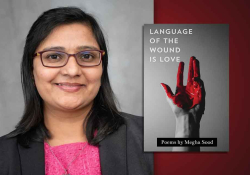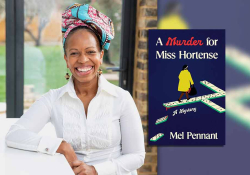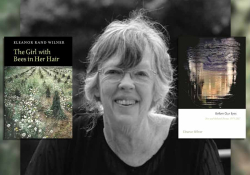Exploring the Burning Questions: A Conversation with Cara Lopez Lee
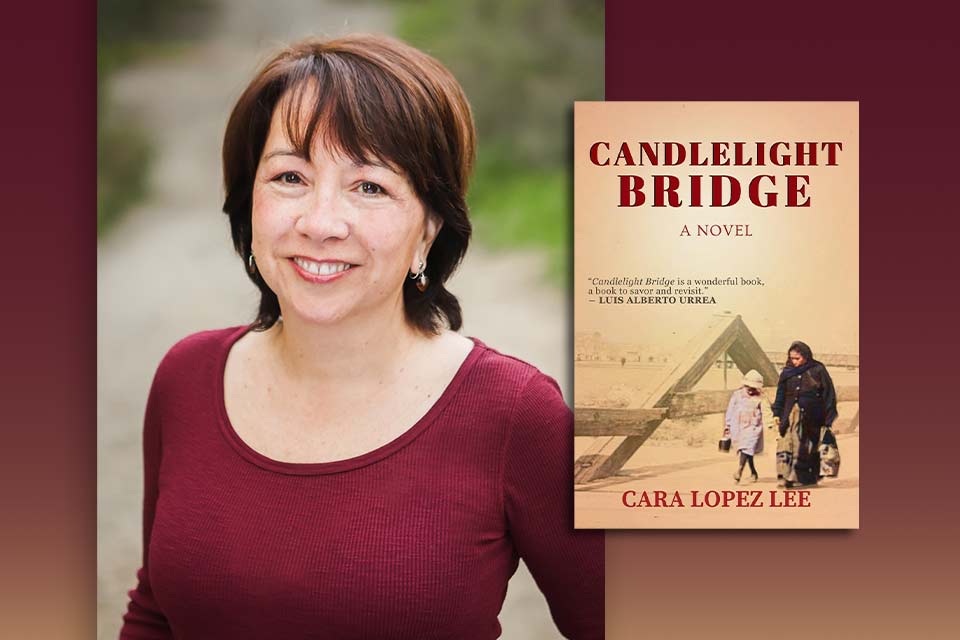 I first came across Cara Lopez Lee on a listserv group (remember those!) for authors who write about Asia. Cara’s memoir, They Only Eat Their Husbands: Love, Travel, and the Power of Running Away, was about to come out—this was ten years ago—and I was intrigued by her story because I, too, had written a memoir, about a rocky relationship in Hong Kong and China and my own running away. At that time, Cara was also working on a novel based on the story of her Chinese great-grandfather and Mexican great-grandmother. When I learned that this novel—Candlelight Bridge (FlowerSong Press)—was going to be published this year, I pushed it to the top of my to-be-read pile. I’m delighted to have this opportunity to discuss with Cara over email her new book, her publishing journey, and writing about two different cultures that are integral to the fabric of the United States.
I first came across Cara Lopez Lee on a listserv group (remember those!) for authors who write about Asia. Cara’s memoir, They Only Eat Their Husbands: Love, Travel, and the Power of Running Away, was about to come out—this was ten years ago—and I was intrigued by her story because I, too, had written a memoir, about a rocky relationship in Hong Kong and China and my own running away. At that time, Cara was also working on a novel based on the story of her Chinese great-grandfather and Mexican great-grandmother. When I learned that this novel—Candlelight Bridge (FlowerSong Press)—was going to be published this year, I pushed it to the top of my to-be-read pile. I’m delighted to have this opportunity to discuss with Cara over email her new book, her publishing journey, and writing about two different cultures that are integral to the fabric of the United States.
Susan Blumberg-Kason: Thank you so much for taking time to talk about Candlelight Bridge! First, congratulations on your new publication. As I mentioned in my introduction, you’ve been working on this book for a long time. I’m sure it seemed never-ending at times, but it’s also encouraging for other writers—including me—to know that these things take time and we can’t rush the publishing process. Can you talk a little about when you first came up with the idea for Candlelight Bridge and what you wanted to emphasize from your great-grandparents’ cultures?
Cara Lopez Lee: I grew up with my paternal grandma, who was a child of Mexican and Chinese immigrants, and I always begged her for family stories: tales of family secrets and tragedies passed down like an inheritance.
In the early 1900s in El Paso, Texas, a Chinese restaurant owner named Ma Bing Sam took a Mexican bride less than half his age. They had ten kids together. He also had sex with his wife’s little sister. He was thirty-six. She was fourteen. That sister, Grace Lopez, gave birth to the family secret: my grandma. For years, he convinced the Lopezes, “Don’t tell anyone I’m the father. If my name’s ruined, who’ll support the family?”
Both sides of the family treated Grandma like an outsider, and she grew into a bitter woman. Whenever I hugged her, her arms never rested comfortably anywhere, as if even her arms never knew where they belonged. Once, when I was four, I ran home crying because a bully beat me up. She said, “I won’t always be here to help you. You have to learn to work things out yourself.” I was always running home but never getting there.
So, in my forties, I started writing this novel to explore my burning question: How do you find home if you feel like you don’t belong? I explored my Mexican and Chinese roots and the similarities and clashes between them. My Mexican Catholic family often prayed to Jesus and Mary, while Chinese families have traditionally paid homage to their ancestors. Yet my Chinese great-grandfather once said he didn’t believe in spirits, only in himself. And when he sexually abused his underage sister-in-law, both cultures treated her like the sinner.
In my novel, some Chinese characters fear a murdered woman will become a hungry ghost. Meanwhile, some of the Mexican kids scare each other with the legend of La Llorona, a ghost who cries over the children she murdered to punish an unfaithful husband. In many cultures when men sin, women bear the guilt. Here’s one question Candlelight Bridge asks: Is America a melting pot where different cultures come together to succeed, or a boiling cauldron where they fight each other to survive?
Here’s one question Candlelight Bridge asks: Is America a melting pot where different cultures come together to succeed, or a boiling cauldron where they fight each other to survive?
Blumberg-Kason: That is a big question, and I’m afraid we’re no closer to figuring that out in 2024 than we were in your great-grandparents’ time. So, stepping back a bit, I got goosebumps reading about Yan Chi’s escape from China during the 1911 Revolution and Candelaria’s escape from the Mexican Revolution around the same time. How did you conduct your research, and how were you able to write so vividly—not only about these places from more than one hundred years ago, but also the political changes in both countries?
Lopez Lee: I’m grateful for your goosebumps. Isn’t it magical how years of endless research and rewrites can create illusions that feel real? I began by interviewing Grandma for many hours, spread over two years. She was reluctant, so I became an emotional archaeologist, chipping away rock to unearth broken treasures. I focused less on historical details than personal memories.
She and her father’s other daughters waited tables together at his restaurant, the Chung King Café. He didn’t pay them, saying, “You get enough in tips.” But Grandma told me a secret: “We paid ourselves.” She and her favorite sister sometimes tore up a customer’s bill and snuck the cash into their pockets instead of the register.
I not only recorded our interviews but other sounds: the two of us rating the Chinese food I brought over, our chopsticks chiming against our bowls, her wistful voice singing an old Ella Fitzgerald tune. After she passed away, those recordings brought Grandma back to life for me, so I could reimagine the past through her eyes. I went on to interview many relatives, locals, and historians from China, San Francisco, Mexico, and El Paso. I studied history books and archives about the Mexican Revolution, America’s borderlands, the migration of Overseas Chinese, and more. I visited every location in the book. The real-life Mexican village of Mata Ortiz became the basis for a fictional pueblo I named Mata Flores.
One turning point came when I traveled to China to seek my great-grandpa’s past. He came from Gong Hau, a district of eleven green and hilly villages, an anachronism of rice paddies, gray brick cottages, and fishponds overseen by old watchtowers. I had no idea which village was his. But locals took me to a ninety-nine-year-old man from a Ma-family village. Old Mr. Ma was so slight I could make out his skull, but he had bird-bright eyes and intense energy. My Mandarin and Cantonese are limited, so I hired a translator, but communication remained tough. I asked questions in English, my translator asked Mr. Ma’s granddaughter in Cantonese, then she asked him in Toisanese. It took ten minutes to explain: “My great-grandfather was Ma Bing Sam, born in 1887, but he left Gong Hau before you were born, Sir, so I don’t expect you to know much. Just hoping for some local history.”
But Mr. Ma refused to give up until he found a connection between us. So, I showed him my great-grandpa’s photo and an old letter from his son.
Mr. Ma’s face lit up. “Hou Hou Hou! Ma Bing Sam!”
A flurry of Chinese flew overhead.
My translator gasped. “Your great-grandpa is from this village!”
Mr. Ma pulled out a red book filled with the names of Git Ngon’s male lineage going back centuries and showed me the page listing Ma Bing Sam and his eldest three sons. What’s more, he had met my great-grandpa when he returned to visit in the 1930s. He said, “Ma Bing Sam had a Mexican wife . . . from Paso?”
My eyes filled with tears.
Mr. Ma invited me to sign the red book.
“But, I’m a woman.”
“It would be our honor,” he said. “You are family.”
I felt Ma Bing Sam was there, finally claiming my family as his, no longer dismissed as a bad branch of the family tree. With my signature, I accepted him too, declaring in writing: “I belong.”
One of my mentors, Luis Alberto Urrea, author of The Hummingbird’s Daughter, often says, “Pick up your pen with love or don’t pick it up at all.” First I had to lay down the bitterness Grandma passed down to me.
Blumberg-Kason: That’s such great advice. I’m sure you get this question a lot, but I’m so eager to know more. Your memoir was so compelling, mainly because when I read it I knew it was all true and I felt like we’re kindred spirits, experiencing many of the same issues. So why did you choose to write Candlelight Bridge as a novel and not a family memoir? Did you find writing fiction was more freeing in this case, since your story begins more than a century ago?
Lopez Lee: Thank you, Susan. Your memoir, Good Chinese Wife, resonated with me too! I love memoirs, but novels are my favorite story form. Fiction gave me freedom to color in gaps in Grandma’s stories. I also wanted to include historical events outside my family. For example, in 2011 I took a road trip through La Frontera: encompassing El Paso, Juárez, and the Chihuahuan Desert. At that time, drug cartels had turned Juárez into what many called the “Murder Capital of the World.” Images of cartel victims hanging under freeway bridges spread all over the news. I’d been waiting since 2006 for things to calm down so I could go. That never happened. I decided to go anyway, with an El Paso friend whose mother and brother live in Juárez, who knew where we might travel safely.
During my research, I’d come across a shocking 2010 article about a town along our passage: in Ascensión, police arrested two teenage boys suspected in a rash of kidnappings that had terrorized local families. Hundreds of enraged locals mobbed the cops, grabbed the two suspects, and beat them to death. I wanted to send that moment back in time one hundred years, imagining something similar might erupt from the tensions of a rising revolution.
On our road trip, we stopped in the real Ascensión, a town that looked too sleepy to kill anyone. In the plaza, weak little trees rose from dying grass, aging cowboys sat muttering on a bench, and a bored barber in an apron leaned against his shop. An eerie silence stretched out to parched cotton fields and endless desert. It felt like an old western before a shootout, the perfect backdrop for an explosive scene.
Blumberg-Kason: You certainly don’t sugarcoat the cultural differences in Candelaria and Yan Chi’s marriage. Since you chose to write a fictional account of your family story, you could have changed it to a more formulaic one that’s common in historical fiction (i.e., a Disney ending). Why did you decide to go with a more realistic narrative, hardships and all?
Lopez Lee: This is a good moment to clarify: Candelaria is not the character inspired by my great-grandma. Her sister Grace is. I tried to make Grace the lead, but she was too young to have enough agency or self-awareness. When I workshopped the story, classmates kept asking, “Why isn’t Candelaria the protagonist?” until the choice became undeniable.
As for my other choices . . . I wanted to honor my family’s history. For me, that meant shining light on the darker choices that made our lives possible. By including both the laughter and tears, I hoped to lay a blessing on the past, and on everyone burdened by family secrets. I love novels not because I want to escape but to elevate, to find beauty in the imperfect human condition.
I love novels not because I want to escape but to elevate, to find beauty in the imperfect human condition.
Blumberg-Kason: Thank you for clarifying that! Switching gears a bit, I feel that most readers assume publishing journeys are quick and without bumps. As we know, that’s usually far from the case. You started this book more than a decade ago. How did you stay motivated?
Lopez Lee: Three practices motivated me most: reading authors I admire such as Isabel Allende and Lisa See, attending workshops, and joining writing communities. I was lucky to find Denver’s Lighthouse Writers Workshop, a nonprofit community of writers supporting writers. There I attended workshops led by published authors like Erika Krouse and William Haywood Henderson. Surrounding myself with writers devoted to mastering their craft inspired me to improve mine.
I’ve also joined other groups, including Southern California’s community of live personal storytellers. Writing stories for the stage gives me much-needed breaks and moments of accomplishment during the marathon of a book project. This shorter form also keeps my editing skills sharp. It took ten years to complete my first draft of Candlelight Bridge—which nobody wanted! Instead of giving up, I upped the ante, taking intensives with major authors like Urrea and Andre Dubus III. Their most powerful feedback: encouraging me to trust that I was onto something. That fueled me through many rewrites.
In recent years I’ve connected with growing communities of Latine and minority writers, who sometimes relate to aspects of my storytelling style and journey that others can’t. These touchstones led me to FlowerSong Press, who published Candlelight Bridge eighteen years after I began.
Blumberg-Kason: You dedicate your book to your sister, the “keeper of our stories.” Can you discuss this a little?
To me that’s a sacred trust, because family histories are history.
Lopez Lee: My sister and I have a unique relationship. She’s twenty-seven. I’m sixty-one. Her mother died when she was two. I have no kids. We don’t pretend to fill those absences, but we are close. She’s my heir, so she’s the one who’ll carry on our family stories. To me that’s a sacred trust, because family histories are history. Our stories define us—as a culture, as a human race.
Blumberg-Kason: Your book is more important than ever, because Chinese and Mexican immigration are still such hot-button topics in the United States. It seems like a never-ending controversy that we should have overcome by now. What are the main messages you wanted to convey in writing your family’s story?
Lopez Lee: All my stories are about the universal desire for home and belonging. Candlelight Bridge’s immigrant characters exemplify the kind of courage Americans value most: they leave behind the familiar, journey to the unknown, and sacrifice to build a better life for themselves and their loved ones. Despite our admiration of those values, we live in times of increased fear and suspicion, when many stereotype refugees and immigrants as criminals and interlopers. I hope my novel decreases the temptation to assume those different from us must be our opponents and increases people’s curiosity to learn the stories of others.
Candlelight Bridge’s immigrant characters exemplify the kind of courage Americans value most.
Blumberg-Kason: And for a lighthearted turn, do you see your book more as a feature-length film or a streaming series? Any preferences for starring and supporting actors?
Lopez Lee: Lucky me if Hollywood ever has to answer this question! I do wonder if Candelaria and Yan Chi might best be played by unknowns, to avoid preconceived notions about them. That said, I can imagine Mexican American actor Xochitl Gomez portraying Candelaria. Gomez played America Chavez in Doctor Strange in the Multiverse of Madness, proving she can simultaneously play ordinary girl and hero, with a vulnerability that can break your heart. Chinese Canadian Simu Liu is a possibility for Yan Chi, with the requisite large head. Still, he might be too handsome and associated with too many good-natured roles, like Asian Ken in Barbie or Marvel superhero Shang-Chi. On the other hand, his piercing eyes might easily switch from villain to Mr. Nice Guy, perfect for the ever-conflicted Yan Chi.
Blumberg-Kason: Superheroes are so fitting! Thank you so much for discussing your wonderful novel!
July 2024

